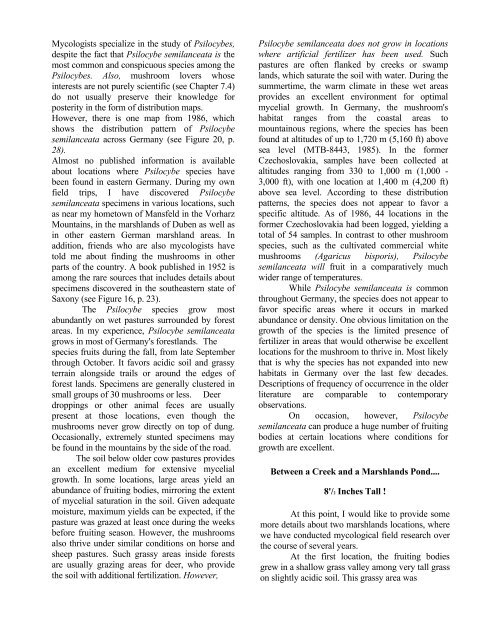Jochen Gartz - Magic Mushrooms Around the ... - preterhuman.net
Jochen Gartz - Magic Mushrooms Around the ... - preterhuman.net
Jochen Gartz - Magic Mushrooms Around the ... - preterhuman.net
Create successful ePaper yourself
Turn your PDF publications into a flip-book with our unique Google optimized e-Paper software.
Mycologists specialize in <strong>the</strong> study of Psilocybes,<br />
despite <strong>the</strong> fact that Psilocybe semilanceata is <strong>the</strong><br />
most common and conspicuous species among <strong>the</strong><br />
Psilocybes. Also, mushroom lovers whose<br />
interests are not purely scientific (see Chapter 7.4)<br />
do not usually preserve <strong>the</strong>ir knowledge for<br />
posterity in <strong>the</strong> form of distribution maps.<br />
However, <strong>the</strong>re is one map from 1986, which<br />
shows <strong>the</strong> distribution pattern of Psilocybe<br />
semilanceata across Germany (see Figure 20, p.<br />
28).<br />
Almost no published information is available<br />
about locations where Psilocybe species have<br />
been found in eastern Germany. During my own<br />
field trips, I have discovered Psilocybe<br />
semilanceata specimens in various locations, such<br />
as near my hometown of Mansfeld in <strong>the</strong> Vorharz<br />
Mountains, in <strong>the</strong> marshlands of Duben as well as<br />
in o<strong>the</strong>r eastern German marshland areas. In<br />
addition, friends who are also mycologists have<br />
told me about finding <strong>the</strong> mushrooms in o<strong>the</strong>r<br />
parts of <strong>the</strong> country. A book published in 1952 is<br />
among <strong>the</strong> rare sources that includes details about<br />
specimens discovered in <strong>the</strong> sou<strong>the</strong>astern state of<br />
Saxony (see Figure 16, p. 23).<br />
The Psilocybe species grow most<br />
abundantly on wet pastures surrounded by forest<br />
areas. In my experience, Psilocybe semilanceata<br />
grows in most of Germany's forestlands. The<br />
species fruits during <strong>the</strong> fall, from late September<br />
through October. It favors acidic soil and grassy<br />
terrain alongside trails or around <strong>the</strong> edges of<br />
forest lands. Specimens are generally clustered in<br />
small groups of 30 mushrooms or less. Deer<br />
droppings or o<strong>the</strong>r animal feces are usually<br />
present at those locations, even though <strong>the</strong><br />
mushrooms never grow directly on top of dung.<br />
Occasionally, extremely stunted specimens may<br />
be found in <strong>the</strong> mountains by <strong>the</strong> side of <strong>the</strong> road.<br />
The soil below older cow pastures provides<br />
an excellent medium for extensive mycelial<br />
growth. In some locations, large areas yield an<br />
abundance of fruiting bodies, mirroring <strong>the</strong> extent<br />
of mycelial saturation in <strong>the</strong> soil. Given adequate<br />
moisture, maximum yields can be expected, if <strong>the</strong><br />
pasture was grazed at least once during <strong>the</strong> weeks<br />
before fruiting season. However, <strong>the</strong> mushrooms<br />
also thrive under similar conditions on horse and<br />
sheep pastures. Such grassy areas inside forests<br />
are usually grazing areas for deer, who provide<br />
<strong>the</strong> soil with additional fertilization. However,<br />
Psilocybe semilanceata does not grow in locations<br />
where artificial fertilizer has been used. Such<br />
pastures are often flanked by creeks or swamp<br />
lands, which saturate <strong>the</strong> soil with water. During <strong>the</strong><br />
summertime, <strong>the</strong> warm climate in <strong>the</strong>se wet areas<br />
provides an excellent environment for optimal<br />
mycelial growth. In Germany, <strong>the</strong> mushroom's<br />
habitat ranges from <strong>the</strong> coastal areas to<br />
mountainous regions, where <strong>the</strong> species has been<br />
found at altitudes of up to 1,720 m (5,160 ft) above<br />
sea level (MTB-8443, 1985). In <strong>the</strong> former<br />
Czechoslovakia, samples have been collected at<br />
altitudes ranging from 330 to 1,000 m (1,000 -<br />
3,000 ft), with one location at 1,400 m (4,200 ft)<br />
above sea level. According to <strong>the</strong>se distribution<br />
patterns, <strong>the</strong> species does not appear to favor a<br />
specific altitude. As of 1986, 44 locations in <strong>the</strong><br />
former Czechoslovakia had been logged, yielding a<br />
total of 54 samples. In contrast to o<strong>the</strong>r mushroom<br />
species, such as <strong>the</strong> cultivated commercial white<br />
mushrooms (Agaricus bisporis), Psilocybe<br />
semilanceata will fruit in a comparatively much<br />
wider range of temperatures.<br />
While Psilocybe semilanceata is common<br />
throughout Germany, <strong>the</strong> species does not appear to<br />
favor specific areas where it occurs in marked<br />
abundance or density. One obvious limitation on <strong>the</strong><br />
growth of <strong>the</strong> species is <strong>the</strong> limited presence of<br />
fertilizer in areas that would o<strong>the</strong>rwise be excellent<br />
locations for <strong>the</strong> mushroom to thrive in. Most likely<br />
that is why <strong>the</strong> species has not expanded into new<br />
habitats in Germany over <strong>the</strong> last few decades.<br />
Descriptions of frequency of occurrence in <strong>the</strong> older<br />
literature are comparable to contemporary<br />
observations.<br />
On occasion, however, Psilocybe<br />
semilanceata can produce a huge number of fruiting<br />
bodies at certain locations where conditions for<br />
growth are excellent.<br />
Between a Creek and a Marshlands Pond....<br />
8'/2 Inches Tall !<br />
At this point, I would like to provide some<br />
more details about two marshlands locations, where<br />
we have conducted mycological field research over<br />
<strong>the</strong> course of several years.<br />
At <strong>the</strong> first location, <strong>the</strong> fruiting bodies<br />
grew in a shallow grass valley among very tall grass<br />
on slightly acidic soil. This grassy area was








![The Big Lie 9-11 and Government Complicity in Mass Murder [PDF]](https://img.yumpu.com/50957077/1/190x245/the-big-lie-9-11-and-government-complicity-in-mass-murder-pdf.jpg?quality=85)








